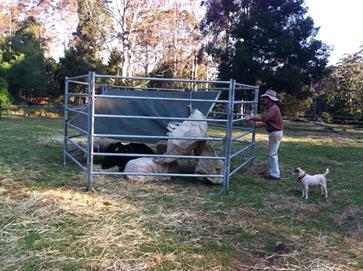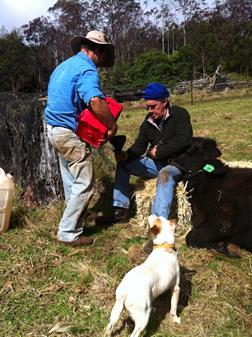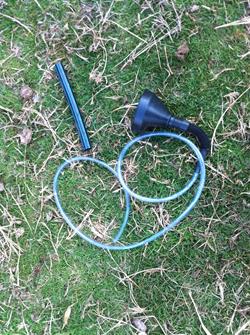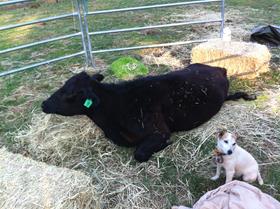Tick Paralysis
Nursing Weaned Cattle with Tick Paralysis
Before nursing, the animal needs to be treated immediately for tick paralysis – read Initial Treatment of Calves and Cattle with Tick Paralysis
- Be prepared for the long haul.
- Nursing may require checking the animal every 4 hours 24/7 for many weeks.
- An improvement in the paralysis may take 7 – 10 days.
- Complete recovery from tick paralysis may take 3 – 4 weeks.
- Paralysis is very stressful to the animal.
- Be thorough and diligent.
- Be patient and thoughtful.
If the animal is Able to walk
- Keep in small flat paddock or yard with shade.
- Supply feed and water.
- Monitor regularly for worsening of the paralysis.
If the animal is Unable to walk

- Move animal to a flat area away from all creeks, dams & gullies.
- To transport a large animal carefully roll animal onto a bulka bag then carefully and slowly drag the bag to the nursing paddock or yard.
- Provide shade.
- Put on halter.
- Once animal is unable to right itself you must keep it in sternal recumbency to prevent bloat. Check the animal’s position every 4 hours 24/7.
To move animal from lying on its side into sternal recumbency:
- Pull on halter (not ears) to lift the animal’s head and forequarters up into a sitting position.
- Fold front legs underneath the brisket.
- Move head around to lie against flank or rest head in a comfortable position on a hay bale.
- Use hay bales to keep animal propped up. Place hay bales at the point of the shoulder.
- Roll onto opposite side every day to keep pressure sores as small as possible.
- Eye care - cover hay bales with sheet to protect eyes when animal throws its head.
If able to chew and swallow,
- hand feed small pieces of barley sprouts. Push them onto the middle of the tongue through the side of the mouth. Feed 4 times a day. Offer good quality hay or chaff.
Check out the video on YouTube:
https://youtu.be/MSFF4WnMzmw - If unable to eat use Ceton as directed (available from your vet).
www.jurox.com.au/products/ceton
If unable to drink
- drench 10+ L water (for 350kg animal) with electrolytes (vytrate) twice a day (available from your vet). www.jurox.com.au/products/vytrate-liquid-concentrate
- The equipment you require to drench is a large funnel, a length of flexible tubing long enough to go from the funnel to the animal’s mid chest, and a piece of poly pipe. Ensure the ends of the tubing are smooth. The poly pipe needs to have a large enough diameter so the tubing can pass through it and the poly pipe needs to be long enough to be easily held at the front of the mouth while the end of the pipe is near the back of the throat. To drench, two people are required – one to pass the tube and keep it in place, the other to attach the funnel and pour in the water and electrolytes or ceton.
Sit on a hay bale and comfortably rest the animal’s head on your lap. Pass the poly pipe between the animal’s lips so one end of the pipe is in front of the mouth and the other end is at the back of the throat. Pass the other hand into the mouth at the side where there are no teeth and firmly hold the poly pipe in place. With your free hand gently pass the tubing through the pipe and down the throat.
The molars should only be able to chew on the poly pipe and not the tubing. Look for the movement made in the skin by the end of the tubing as it passes down the side of the neck on the near side. Sometimes you will see it, sometimes you won’t. If you can see the end of the tube as it moves down the neck, it means the tubing is in the oesophagus (the right place) and not the wind pipe (the wrong pace).
Once you have passed enough tubing place the end of the tubing against your cheek and feel for hot breath on your cheek. If you feel hot breath, then you know the tubing is in the wind pipe (the wrong place).
If the tubing is in the wind pipe remove the tubing and try again. Once you are confident that the tube is in the oesopahgus (the right place), attach the funnel and slowly pour in the water and electrolytes or ceton.
Once finished, quickly pull out the tubing and then remove the poly pipe.


- Once the animal is able to sit upright, fold legs in underneath so it is resting on its brisket.
- As the animal regains strength, it may throw itself around and damage its eyes and legs. This is difficult to stop as the animal is trying to stand but is not yet strong enough.
- Long term complications:
- pressure sores
- injury to legs
- injury to eyes
- pneumonia.

This heifer weighed 350kg when she developed severe tick paralysis. She could only move the tips of her ears and breathe. On day 2 she was able to chew small amounts of barley sprouts when they were placed into her mouth and she was able to swallow although her tongue movement was minimal. On day 8 of nursing the heifer showed the first signs of improvement (by lifting her head). On day 14 she could eat a little hay and drink from a bucket, and on day 18 she was able to stand. The heifer made a full recovery and delivered a calf 12 months later.
